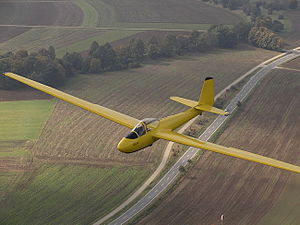The LF-107 Luňák (English: Kite) is a Czech aerobatic glider designed by Prague-based company Rudý Letov in the late 1940s. The design was developed within a prolific group of aeronautical engineers and sailplane pilots, including K. Dlouhý (later author of LET L-13 Blaník), J. Matejček, and B. Boček, led by chief designer Vladimír Štros.
| LF-107 Luňák | |
|---|---|

| |
| Role | Aerobatic glider |
| Manufacturer | Letov |
| First flight | 25 June 1948 |
| Number built | 75 |
Design and development edit
The first flight of the prototype took place on June 25, 1948, and a second prototype flew in July. The prototype participated later in the same year in aerobatic competition in Grenchen, Switzerland, and in Ziar, Poland in 1949, where its good aerobatic and gliding characteristics drew considerable attention.
Unfortunately, serial production was disrupted by geopolitical developments, as the factory was charged with production of MiG-15, MiG-19, MiG-21F aircraft, and access to Western civil export markets were progressively hampered by the emergence of the Iron Curtain. Therefore, only 75 examples of the Luňák were produced.
In 1950, a variant with simpler construction and a revised cockpit, among other changes, was developed. This LF-107 Luňák of wooden construction designated Letov VT-7 under the military training system was instrumental in the development of gliding and aerobatics in the Czech Republic. The LF-107 was also used for aerobatic training in the Soviet Union, Bulgaria, Romania and Poland.
XLF-207 Laminar edit
The Letov XLF-207 Laminar, a derivative of the Luňák, was the first glider in the world with a laminar flow wing.[citation needed] Its maiden flight took place in Praha Letnany in August 1951. Research into laminar flow wings was carried out by the XLF-207 Laminar, an LF-107 fitted with laminar flow wings. Presently there are only nine airworthy Luňáks, two of which are in the United Kingdom. A Luňák is displayed in the American Museum of Flight.
Variants edit
- LF-107 Luňák
- The initial production version of this aerobatic glider, 75 built.
- VT-7
- Simpler construction with a revised cockpit for use by the Czech military.
- XLF-207 Laminar
- The Letov XLF-207 Laminar was the first glider in the world with a laminar flow wing. Its maiden flight took place in Praha Letnany in August 1951.
Specifications (LF-107 Luňák) edit
Data from [1]
General characteristics
- Crew: one
- Length: 6.78 m (22 ft 3 in)
- Wingspan: 14.27 m (46 ft 10 in)
- Wing area: 13.38 m2 (144.0 sq ft)
- Aspect ratio: 15.22
- Empty weight: 205 kg (452 lb)
- Gross weight: 310 kg (683 lb)
Performance
- Maximum speed: 300 km/h (190 mph, 160 kn)
- Maximum glide ratio: 24 at 80 km/h (43kts)
- Rate of sink: 0.85 m/s (167 ft/min) at 65 km/h (35kts)
See also edit
References edit
- ^ Simons, Martin (2006). Sailplanes 1945–1965 (2nd revised ed.). Königswinter: EQIP Werbung & Verlag GmbH. ISBN 3-9807977-4-0.
Further reading edit
- German Wikipedia article de:Letov LF 107 Luňák
- Peter Mallinson and Mike Woollard, Handbook of Glider Aerobatics